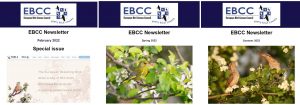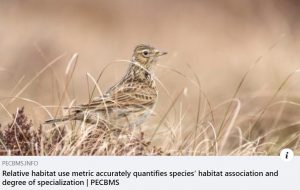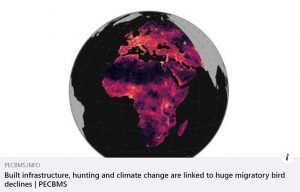Report on the Pan-European Common Bird Monitoring Scheme, September 2022
September 8, 2022
This report summarises the Pan-European Common Bird Monitoring Scheme (PECBMS) activities between 17 December 2021 and 31 August 2022.
Summary
We have made many innovations to our tools and dataset in this period, which led to improved supranational species indices and indicators and speeded up the process of data gathering, data control and calculations. In the 2021 update released on 6 December, we included two new monitoring schemes’ data from Croatia and Flanders, so the outputs are based on data covering 40 years from 29 countries, including 26 EU MS – all but Malta, where no regular bird monitoring scheme is running. We updated the network with regular newsletters and web articles. The PECBMS data was used in two scientific papers published in respected peer-reviewed journals. We contacted all EU MS coordinators and agreed on national indicators delivery for policy purposes via PECBMS. Moreover, we gathered all national farmland bird indicators produced so far and the species lists behind them. We met EU stakeholders several times and provided answers and advice upon request. Finally, we attended the EBCC Board meeting and presented the progress of the PECBMS.
Project funding
The project is secured by the EC tender called “Technical and scientific support in relation to the delivery and development of wild bird indicators for the EU“.
Production of European species trends and indices
Data collection comprised a couple of essential phases that overlapped with each other. First, a personal data request was sent to all coordinators on 18–24 March 2022. Data was checked when delivered by national coordinators. National indices from most countries were calculated by a new tool called RTRIM-shell. Computation procedure, data quality control, and presented indices and trends are generally consistent with the update in 2021.
We completed data revision on a national level on 20 August 2022. We used a tool (in an R-script) gathering criteria used to select national data for better comparison between countries and orientation among datasets delivered by all the PECBMS countries. In addition, this tool points out the problematic data on a national level to assess its use for supranational index calculation.
Next to the data revision of PECBMS countries, we ran a thorough revision of the PECBMS candidate countries. Results of this revision led to the inclusion of the Andorran monitoring scheme in PECBMS this year.
Data till 2021 collected
Delay in data delivery shrank from two years to one year in most countries. Therefore, we use data till 2021 (instead of 2020) in the 2022 update, which is a big step forward. We have always been asked to make our delay smaller, but data collection hampered this process in many countries. Fortunately, the situation changed recently, and today, only a few countries cannot deliver data with a one-year delay.
Site-level data and online tool
In 2022, we have updated the site-level data sets until 2019–2021 for Andorra, Austria, Bulgaria, Czech Republic, Estonia, Flanders, Germany, Greece, Hungary, Poland, Spain, and the UK, including all species recorded in the sites. We have also launched a new online tool for site-level data collection and quality control, which allows automatic data checks, data visualization in maps, better communication with national coordinators and data exports. This tool was presented to PECBMS national coordinators in a webinar in March 2022 and at the EBCC conference in April 2022.
Technical improvements
We modified and justified the hierarchical step-by-step computation procedure to include data from Andorra for the first time.
A new version of i) Tool for data RTRIM-shell input preparation, ii) RTRIM-shell and iii) a brand new program for RTRIM-shell output modification for upload to the Online tool was made. There always appear special needs in specific countries. National coordinators usually announce their needs and solution via our Slack forum so that the whole community can share this knowledge. PECBMS coordinator gathers these changes and then releases a new version of the R scripts.
RTRIM-shell was also modified to the needs of European coordinators, so PECBMS coordinators can gain information which was missing in RTRIM-shell up to now but appeared in outputs of the old TRIM/BirdStats program.
The transformation from TRIM to RTRIM-shell continued by supporting the national coordinators through online personal meetings (Czech Republic, Ireland, Bulgaria, Spain, Slovakia, and France), helping them with their problems. As a result, most coordinators delivered indices in the form of RTRIM-shell outputs.
The online tool for national data exports and revision (counted in TRIM/BirdStats and RTRIM-shell) was finished in 2021. In 2022, this Online tool was updated according to national coordinators’ comments. Another update improving the user-friendly environment for national coordinators is already planned together with ICO for the year 2023.
RTRIM-shell On-line tool (an online tool for collecting output files from national coordinators, including automatic data quality control) has been improved and communicated via the website in 2020. The RTRIM shell version 1.4 was updated on 1 March 2022.
Presentation of results and promotion
PECBMS contributed to spring, summer, and a special issue of the EBCC Newsletter spread to 647 recipients. See an archive of the newsletter.

PECBMS website www.pecbms.info has been actualised regularly. In the given period, we published 11 news, updated the list of publications, PECBMS methods, and the information on the bird monitoring schemes in Europe and national indicators. We updated the page presenting the national coordinators of European bird monitoring schemes in the PECBMS and filled it with new portraits from Cyprus and Sweden.
To address the wider public, we maintained the Facebook and Twitter profiles and updated the posts regularly every week – 18 news from 16 December 2022 until 8 September 2022.
In 13–14 June 2022, Alena Klvaňová was invited to a conference Protection of meadow birds – a hopeless case?, organised by Brandenburg Akademy „Schloss Criewen“, a German-Polish center for environmental education and meeting center. She was asked to give a talk on Common meadow bird species trends across Europe and a practical example of their protection – bird parks in Czechia.
Research
In February, together with the scientists from the University of East Anglia in collaboration with the PECBMS network, we published new research on species’ habitat association in Ecological Indicators. We explored the ‘relative habitat use’ (RHU) metric as a means of quantifying species’ habitat association and degree of specialization. We recommend the RHU metric as a useful tool in conservation management strategies to protect habitat specialists and their habitats and thus support national and international progress towards reaching biodiversity targets.

In June, we published a new research mapping the threats for the migrating birds in Global Ecology and Biogeography, a joint project of the University of East Anglia, the University of Porto and the University of Lisbon (both Portugal) and the Czech Society for Ornithology (Czech Republic). A new study, which was also based on the PECBMS data, reveals that population declines have been greatest among species that migrate to areas with more human infrastructure – roads, buildings, power lines, wind turbines – and higher population densities and hunting levels. Habitat degradation and climate change have also played a part in driving long-term declines.

PECBMS data was used in the following publications (the contractors and subcontractors are marked in bold):
- Buchan, C., Franco, A. M. A., Catry, I., Gamero, A., Klvaňová, A., & Gilroy, J. J. 2022: Spatially explicit risk mapping reveals direct anthropogenic impacts on migratory birds. Global Ecology and Biogeography, 00, 1–19. https://doi.org/10.1111/geb.13551
- Fränzi Korner-Nievergelt, Nicolas Strebel, Stephen T. Buckland, Robin Freeman, Richard D. Gregory, Jérôme Guélat, Nick Isaac, Louise Mc Rae, Tobias Roth, Saskia Schirmer, Leo L. Soldaat, Petr Voříšek, Thomas Sattler 2022: Multi-species population indices for sets of species including rare, disappearing or newly occurring species. Ecological Indicators, Volume 140, 109005, ISSN 1470-160X, org/10.1016/j.ecolind.2022.109005
- Enya O’Reilly, Richard D. Gregory, Ainars Aunins, Lluís Brotons, Tomasz Chodkiewicz, Virginia Escandell, Ruud P.B. Foppen, Anna Gamero, Sergi Herrando, Frédéric Jiguet, John A. Kålås, Johannes Kamp, Alena Klvaňová, Aleksi Lehikoinen, Åke Lindström, Dario Massimino, Ingar Jostein Øien, Jiří Reif, Eva Šilarová, Norbert Teufelbauer, Sven Trautmann, Chris van Turnhout, Thomas Vikstrøm, Petr Voříšek, Simon J. Butler 2022: An assessment of relative habitat use as a metric for species’ habitat association and degree of specialization. Ecological Indicators, Volume 135, 108521, ISSN 1470-160X, DOI: 10.1016/j.ecolind.2021.108521
Maintain and update the network of cooperating organisations and individuals
Up to date, the PECBMS list of contacts contains 930 individual references from 64 countries or territories, of which 390 are on the PECBMS mailing list, including coordinators of national monitoring schemes, EBCC national delegates, and BirdLife partner organisations, as well as policy people and decision-makers.
We provided advice and consultations to the national coordinators upon request:
- Expert opinion on Lithuanian Forest Bird Index, which is parallel to the Farmland Bird Index (FBI)
- Comparison of Belgian national indices calculated by Belgian vs PEBMS coordinators. This step was done to see what differences appear. Despite there being some differences in Belgian and PECBMS combined indices, they are quite small, so generally, they shouldn’t be confusing for index users and other audiences.
- Assistance to the coordinator of the Greek monitoring scheme and advice on improving the state of bird monitoring in Greece
- Regular meetings with the coordinators from Moldova and Montenegro, presenting the Moldovian scheme on the website
- Expert opinion and help with the combination of two Czech monitoring schemes
On 4 March, we organised the second PECBMS webinar (via Zoom) dedicated to the RTRIM shell and related topics. We guided the national coordinators from the data preparation to data validation in the online tool. Moreover, Anna Gamero introduced the new site-level data online tool which will be accessible to all the coordinators very soon. Over 30 participants, mainly national coordinators, attended the event.
The PECBMS workshop took place on Monday 4 April at 2.30–5.30 PM during the EBCC conference Bird Numbers 2022 in Lucerne. We introduced the project progress since the last Bird Numbers conference in Evora in 2019, the selected national coordinators presented individual scheme news and authors from the PECBMS network presented research outputs and plans for future developments. Over 50 participants attended the workshop.
Agenda points
Report on the progress of the PECBMS (60 min)
Alena Klvaňová: Welcome, a summary of the PECBMS activities 2019–2021
Eva Šilarová: Technical update (data revision, new programs, online tools)
Anna Gamero: Presentation of the new site-level online tool
Petr Voříšek: The concept of the International Census Plots (ICP), experience from the pilot year, and plans for the future
Time for coordinators: updates and questions (60 min)
List of countries presenting their schemes:
Czechia
Denmark
Estonia
Croatia
Finland
Germany
Norway
Spain
Switzerland
Presentations on research outputs and future development (60 min)
Karine Princé: Embedding the FBI into the CAPRI model for the European Commission and projects mobilizing the French BBS data (Natura 2000 assessment, data combination with opportunistic records, etc.)
Fränzi Korner-Nievergelt & Thomas Sattler: The problem of disappearing or newly occurring species in multi-species indices and how to resolve it
Enya O´Reilly, Simon Butler: Relative habitat use (RHU) metric accurately quantifies species’ habitat association and degree of specialization
Henk Sierdsema, Christian Kampichler: Distribution modeling with SDMaps (an update about modeling techniques available for CBM coordinators)
Active communication with EU stakeholders
We assisted the project stakeholders via e-mail or online discussions. We regularly assisted Luisa Samarelli and Jean-Paul Torre with issues regarding the FBI implementation in the new Nature Restoration Law or forest bird indicator production in EU MS.
Reporting to the EBCC Board
On 7 March and on 6 July, we attended the EBCC Interim Board meetings, and on 4 April, we participated at the EBCC Board meeting, and on 6 April at the EBCC Annual General Meeting. Since the last meeting, we have presented the PECBMS schedule and the project progress.
We report quarterly to the PECBMS Steering and Technical Group on the project progress. On 28 March, PECBMS Steering and Technical Group met via Zoom. The coordination team reported on the current state of the scheme. In addition, we discussed the scheme’s future development.






